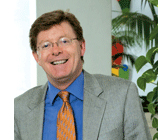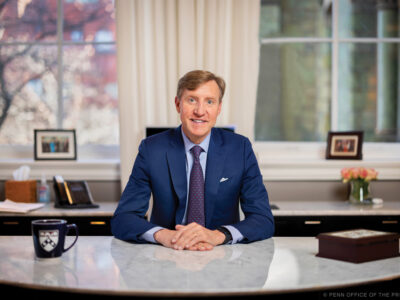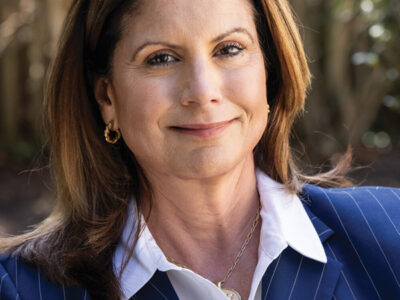
On May 28, after an international search that lasted nearly half a year and considered more than 180 candidates, the University named Vincent Price as its 29th provost. Price is a familiar face on campus. The Steven H. Chafee Term Professor of Communication in the Annenberg School, and a professor of political science in the School of Arts and Sciences, he is also a veteran administrator. In his 11 years at Penn, Price has served as associate provost for faculty affairs, chair of the Faculty Senate, and associate dean of the Annenberg School. He has also been the interim provost since March 1, when Ronald Daniels stepped down to become president of Johns Hopkins University [“Gazetteer,” Jan|Feb].
Price will formally assume the office on July 1, after ratification by the University’s trustees.
“What’s so delightful about stepping into the provost’s office,” Price told the Gazette the day after his selection was announced, “is that it deepens your appreciation for all the forms of expertise that an institution like Penn has gathered, from top to bottom. We have the benefit of extraordinary students who meet almost unbelievable admissions criteria. We have managed to recruit a world-class faculty. We also have extraordinary staff at Penn,” he said. “And that’s not even to begin to say anything about our tremendous network of alums.”
He also took some time to answer a few questions.
Penn’s last provost came to the position as a fresh face with no prior affiliation to the University. What do you see as the advantages—and disadvantages—of rising to the post from within?
There’s certainly no downside to loving Penn. I think that one of the advantages is that in my time on the faculty, I’ve had the opportunity to interact in a wide range of ways with the schools and the central administration. I’ve been able to work with the Faculty Senate as one of its chairs. I’ve been able to serve as associate provost of faculty affairs, serve as associate dean in the Annenberg School, work with undergraduate curriculum, work with graduate studies, supervise doctoral students. These are all experiences that run the gamut of the kinds of the things that the provost has to oversee.
There are cultural differences between campuses, and Penn has its own ways of doing business, its own educational and administrative culture. So I think that familiarity gives someone a sense of how best to navigate and how best to collaborate when it comes to problem-solving and advancing the core priorities of the institution.
What would you single out as the most substantive accomplishments of Ron Daniels’ tenure?
He did a number of very important things. Just one example that I’m experiencing now: Within the provost’s office, he’s assembled a very strong staff. I’m delighted to be working day to day with Steve Fluharty, our vice provost for research, and Andy Binns, our associate provost for education. These are faculty leaders I’ve been working with in my faculty affairs role, but as interim provost I’ve come to depend on them heavily for lots of assistance. And Ron is responsible for having built that staff. We have an enormously talented team, and that’s to his great credit. And the fact that as interim provost I was able to step in, and things ran as smoothly as they did, is testament to that.
You’ve been the interim provost since March, so you’ve had a chance to take stock of the broad academic landscape at Penn. Are there any departments you plan to devote particular time and resources to, either to expand their footprints or nudge them toward a different patch of academic terrain?
I have ideas, but I want to spend my first few months as provost listening to the ideas of students, faculty, and staff. Over the summer I plan to sit down with faculty. I have been in regular conversations with deans, and I plan to continue those. Obviously everyone has their own view of what will help Penn continue its rise to eminence. I think we have a particular interest in advancing our international initiatives, and bringing them to a new level of strategic coherence and support from the provost’s office. I think each of the schools, which have been spending the year in light of the economic downturn looking carefully at their core priorities, have really done a very good job of identifying opportunities to build their core strengths, and to use this time of economic pressure to highlight their most critical priorities.
Are there any areas where you think the University ought to scale back, or become leaner?
I think in every school, the deans have been looking at various programs and ways we can more effectively manage resources, by way, for example, of appointing faculty jointly to two programs rather than doing as much faculty hiring as we would have. Penn is quite good at stretching a dollar, and drawing as much educational value out of every dollar as we possibly can. I think we’re perfecting that.
The Museum has shrunk its staff and shifted its mission a bit in the last year. Has it reached a stable status quo, or is the situation there still in flux?
Well I wouldn’t say that it’s shifted its mission. It’s working with a new strategic plan, and I think one of the misunderstandings about the Museum is that its restructuring had to do with any diminution of its commitment to research. These positions had to be reconfigured to help the Museum move forward. But its larger mission is really driven by an interest in consolidating its research mission, helping bring new focus to that and connect it as effectively as possible to work being done elsewhere in the University. And at the same time, taking advantage of the Museum’s collections to mount new exhibits and give more vigor to its public presence in the region. So the Museum, I would say, is still in the process of working through some of its administrative restructuring. But I think it’s on a very good trajectory.
Recently The Chronicle of Higher Education asked whether higher education will be the next bubble to burst, noting that average college tuition and fees have risen 440 percent in the last 25 years, and the financial rug has recently been yanked out from under a lot of people’s feet. Do you think the current circumstances introduce a new kind of challenge to the provost’s job description?
Lean economic times always present challenges. There certainly are some new limitations on resources that every unit is dealing with in different ways. I think those challenges come with significant opportunities as well. And in fact, Penn institutionally is quite well positioned. We entered this economic downturn in strong fiscal shape, and without some of the liquidity problems that have presented enormous challenges to our peer institutions. So we have actually been able to convert, in some respects, this downturn into a significant opportunity. Some of our schools, for example, have had great success in recruiting faculty in markets that had been previously somewhat overheated, and have actually been able to redress some fairly longstanding concerns about faculty losses that had accumulated in previous years. At the same time, I think every time a new investment is considered, it is scrutinized more carefully. And that’s somewhat clarifying.
We have a structure at Penn that’s administratively decentralized, we have a budgetary system that’s decentralized, we have good open channels of communication between the schools and the provost’s office, and I’ve been struck by just how well, institutionally, Penn has responded.
You’ve taught at the undergraduate and graduate level here at Penn. What does a professor give up to become a top administrator?
There’s a tradeoff. I am spending less time teaching. My research work clearly will not have benefit of the hours I’ve had to spend on it in the past. So there’s no question that you step back from those research and teaching activities. And that’s difficult to do. When you love working with students, and you’ve spent a career publishing with students and faculty colleagues, it’s quite difficult giving up all the time you spend doing those things.
What you gain in exchange for that, though, is a deepened sense of how that whole enterprise—the work of education, the work of scholarly research—depends upon a lot of community-building and infrastructure that takes tremendous time and attention and planning. And it’s a different kind of intellectual challenge to grapple with how best to carry out those activities, and how best to support our faculty in their teaching and research, and how to create the optimal environment for our students. How to find the money to fund graduate student stipends. How to produce the kinds of resources that permit the access to higher education that Penn has committed itself to advancing. Those things take a tremendous amount of work. We can’t expect our faculty individually to do these things. Yet if we don’t do those things, even the best collection of faculty and students in the world will not produce what we hope they will.




